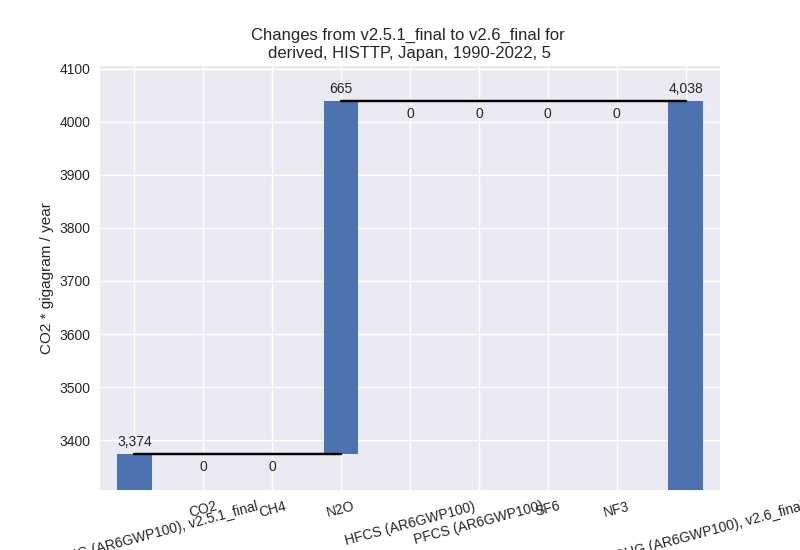Changes in PRIMAP-hist v2.6_final compared to v2.5.1_final for Japan
2024-09-24
Johannes Gütschow
Change analysis for Japan for PRIMAP-hist v2.6_final compared to v2.5.1_final
Overview over emissions by sector and gas
The following figures show the aggregate national total emissions excluding LULUCF AR6GWP100 for the country reported priority scenario. The dotted linesshow the v2.5.1_final data.

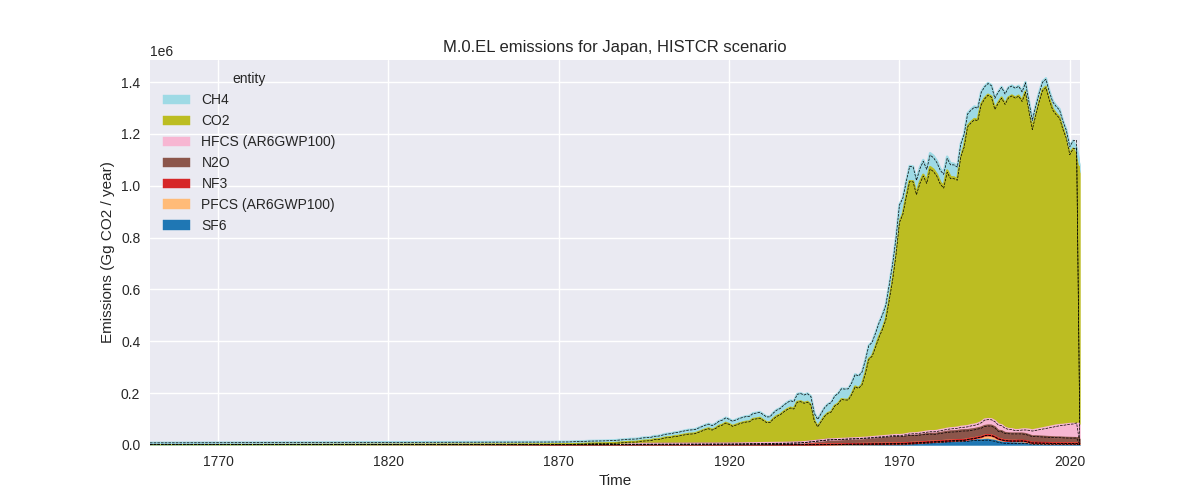
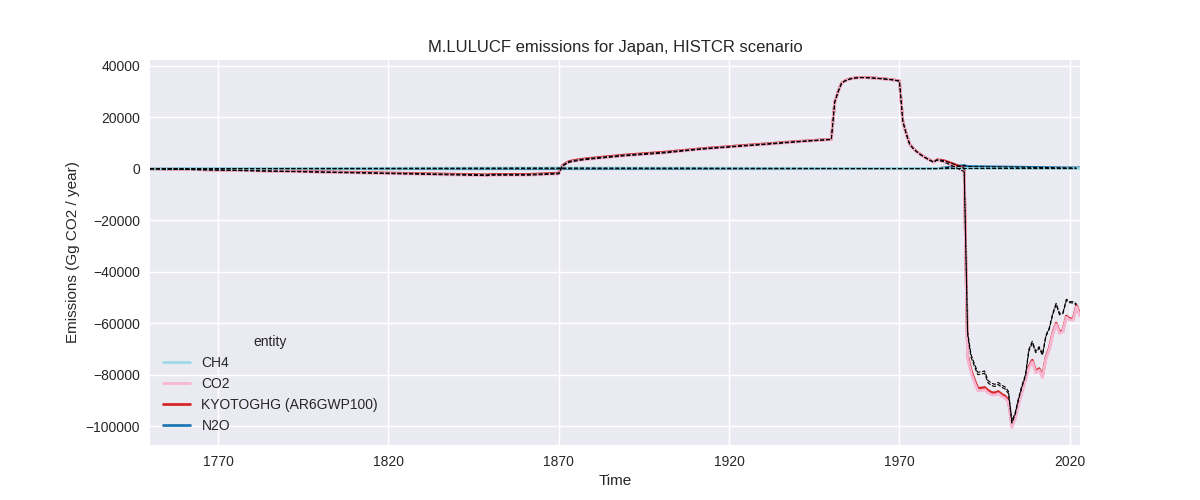
The following figures show the aggregate national total emissions excluding LULUCF AR6GWP100 for the third party priority scenario. The dotted linesshow the v2.5.1_final data.
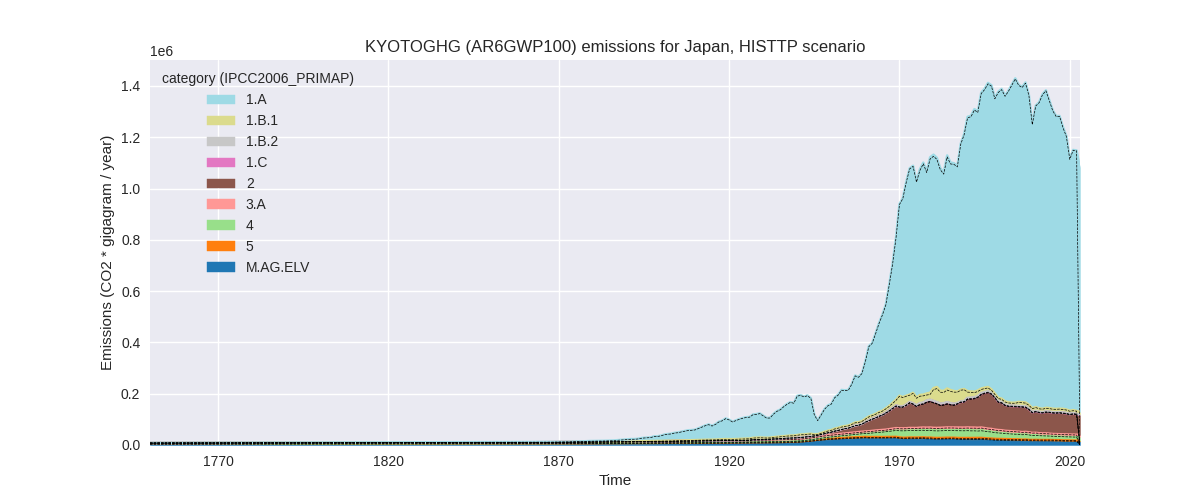
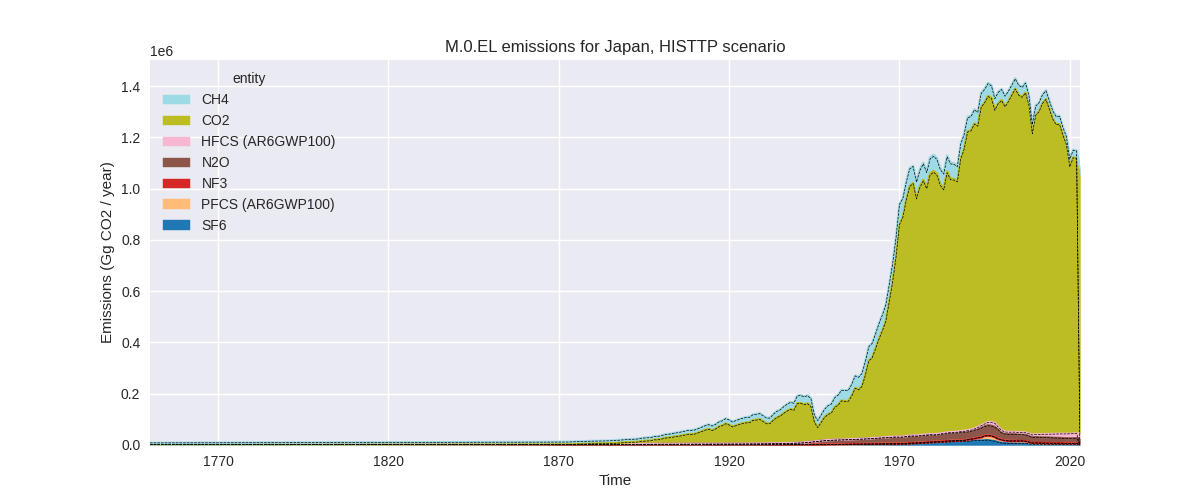
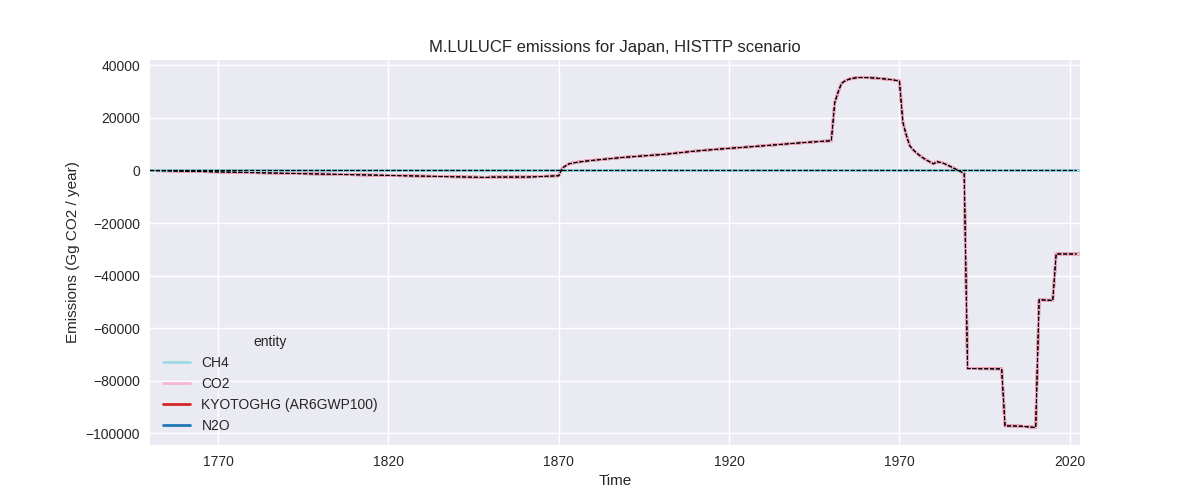
Overview over changes
In the country reported priority scenario we have the following changes for aggregate Kyoto GHG and national total emissions excluding LULUCF (M.0.EL):
- Emissions in 2022 have changed by -2.5%% (-29571.30 Gg CO2 / year)
- Emissions in 1990-2022 have changed by 0.1%% (1666.47 Gg CO2 / year)
In the third party priority scenario we have the following changes for aggregate Kyoto GHG and national total emissions excluding LULUCF (M.0.EL):
- Emissions in 2022 have changed by 0.2%% (1739.30 Gg CO2 / year)
- Emissions in 1990-2022 have changed by 0.2%% (2603.46 Gg CO2 / year)
Most important changes per scenario and time frame
In the country reported priority scenario the following sector-gas combinations have the highest absolute impact on national total KyotoGHG (AR6GWP100) emissions in 2022 (top 5):
- 1: 1.A, CO2 with -24070.43 Gg CO2 / year (-2.4%)
- 2: 2, HFCS (AR6GWP100) with -4358.95 Gg CO2 / year (-7.5%)
- 3: 3.A, N2O with 934.76 Gg CO2 / year (36.1%)
- 4: M.AG.ELV, N2O with -793.08 Gg CO2 / year (-12.9%)
- 5: 2, NF3 with -337.91 Gg CO2 / year (-48.2%)
In the country reported priority scenario the following sector-gas combinations have the highest absolute impact on national total KyotoGHG (AR6GWP100) emissions in 1990-2022 (top 5):
- 1: 1.A, CO2 with -1226.10 Gg CO2 / year (-0.1%)
- 2: 3.A, N2O with 1141.28 Gg CO2 / year (43.6%)
- 3: M.AG.ELV, N2O with -996.28 Gg CO2 / year (-14.6%)
- 4: 2, HFCS (AR6GWP100) with 748.07 Gg CO2 / year (2.6%)
- 5: 2, CO2 with 691.91 Gg CO2 / year (1.3%)
In the third party priority scenario the following sector-gas combinations have the highest absolute impact on national total KyotoGHG (AR6GWP100) emissions in 2022 (top 5):
- 1: 2, HFCS (AR6GWP100) with -1068.37 Gg CO2 / year (-5.5%)
- 2: 2, CO2 with 782.94 Gg CO2 / year (1.5%)
- 3: 4, CH4 with 747.98 Gg CO2 / year (9.5%)
- 4: 1.A, CO2 with 696.40 Gg CO2 / year (0.1%)
- 5: 2, N2O with 461.02 Gg CO2 / year (43.6%)
In the third party priority scenario the following sector-gas combinations have the highest absolute impact on national total KyotoGHG (AR6GWP100) emissions in 1990-2022 (top 5):
- 1: 2, CO2 with 836.05 Gg CO2 / year (1.2%)
- 2: 4, CH4 with 665.61 Gg CO2 / year (4.7%)
- 3: 5, N2O with 664.71 Gg CO2 / year (19.7%)
- 4: 2, N2O with 152.07 Gg CO2 / year (3.7%)
- 5: 4, N2O with 79.61 Gg CO2 / year (3.4%)
Notes on data changes
Here we list notes explaining important emissions changes for the country. ’' means that the following text only applies to the TP time series, while means that it only applies to the CR scenario. Otherwise the note applies to both scenarios.
- We have included the 2024 release of the official Japanese GHG inventory.
- Energy CO2 emissions are lower than in v2.5.1 because 2022 growth rates in the inventory data are lower than in EI2023 data. HFCs emissions are lower for the last years.
- Agricultural N2O emissions have a different distribution to subsectors because the detail of the inventory data is not sufficient for a full mapping to IPCC2006 categories and indirect emissions from manure management are grouped with direct emissions in 3.A instead of 3.C.6.
- Cumulative emissions changes for individual sectors in the CR scenario are due to the lower HFCs data and the agricultural N2O subsector assignment. Total cumulative emissions are almost unchanged.
- Changes in the TP scenario are small and limited to subsectors.
Changes by sector and gas
For each scenario and time frame the changes are displayed for all individual sectors and all individual gases. In the sector plot we use aggregate Kyoto GHGs in AR6GWP100. In the gas plot we usenational total emissions without LULUCF. ## country reported scenario
2022
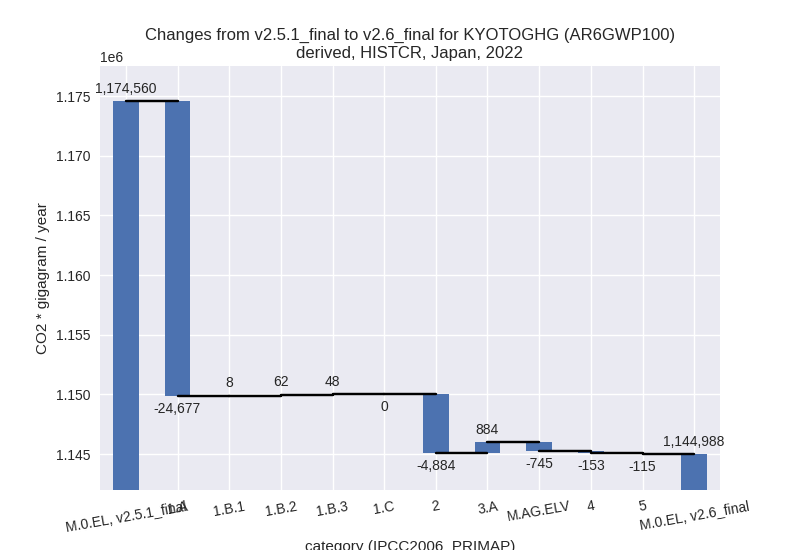
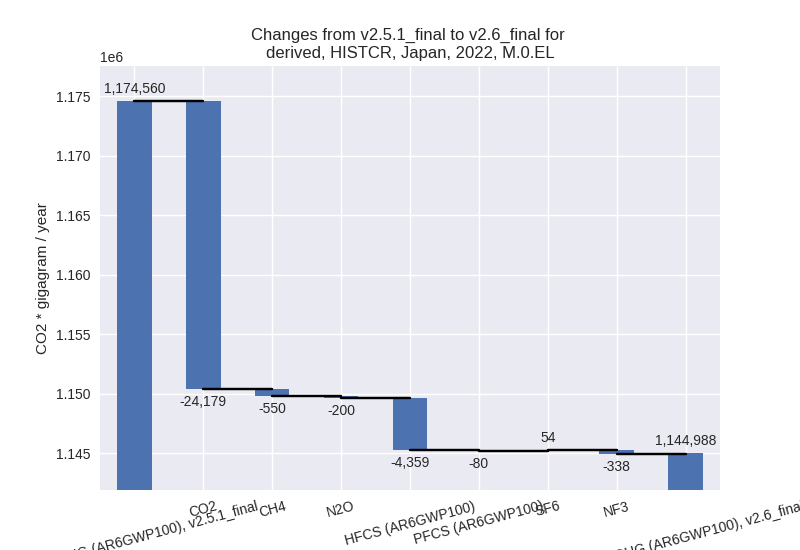
1990-2022
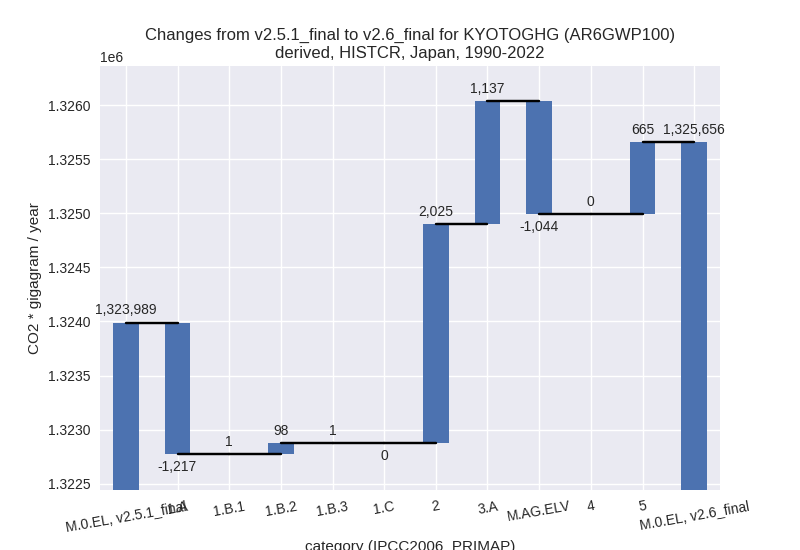

third party scenario
2022
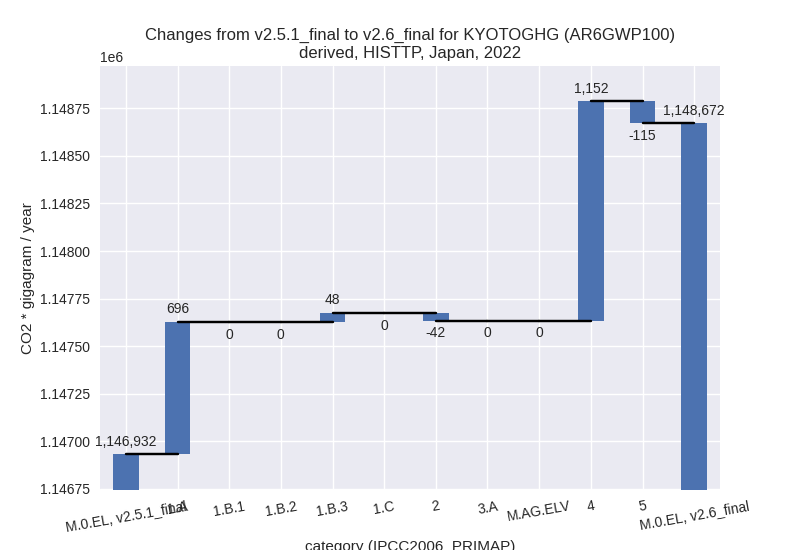
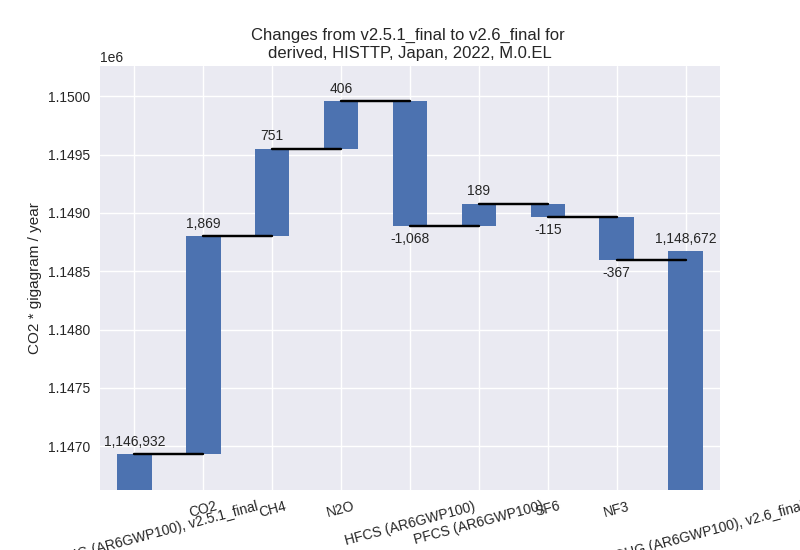
1990-2022
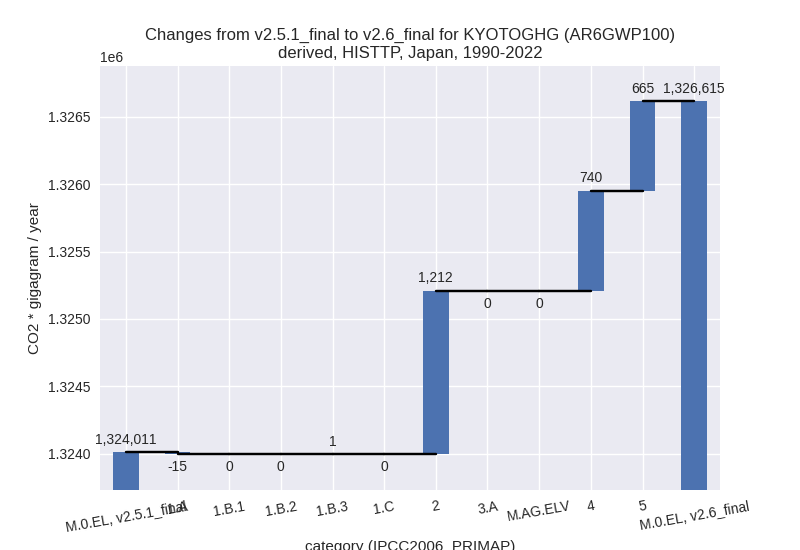
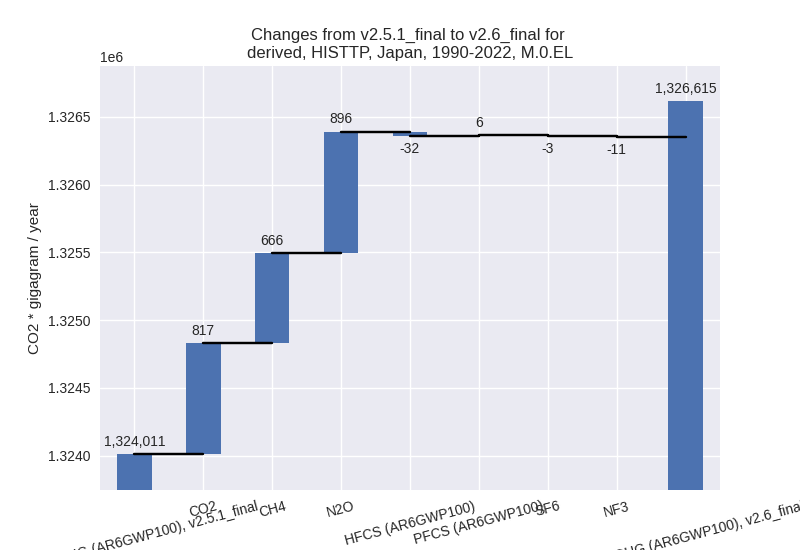
Detailed changes for the scenarios:
country reported scenario (HISTCR):
Most important changes per time frame
For 2022 the following sector-gas combinations have the highest absolute impact on national total KyotoGHG (AR6GWP100) emissions in 2022 (top 5):
- 1: 1.A, CO2 with -24070.43 Gg CO2 / year (-2.4%)
- 2: 2, HFCS (AR6GWP100) with -4358.95 Gg CO2 / year (-7.5%)
- 3: 3.A, N2O with 934.76 Gg CO2 / year (36.1%)
- 4: M.AG.ELV, N2O with -793.08 Gg CO2 / year (-12.9%)
- 5: 2, NF3 with -337.91 Gg CO2 / year (-48.2%)
For 1990-2022 the following sector-gas combinations have the highest absolute impact on national total KyotoGHG (AR6GWP100) emissions in 1990-2022 (top 5):
- 1: 1.A, CO2 with -1226.10 Gg CO2 / year (-0.1%)
- 2: 3.A, N2O with 1141.28 Gg CO2 / year (43.6%)
- 3: M.AG.ELV, N2O with -996.28 Gg CO2 / year (-14.6%)
- 4: 2, HFCS (AR6GWP100) with 748.07 Gg CO2 / year (2.6%)
- 5: 2, CO2 with 691.91 Gg CO2 / year (1.3%)
Changes in the main sectors for aggregate KyotoGHG (AR6GWP100) are
- 1: Total sectoral emissions in 2022 are 989327.69
Gg CO2 / year which is 86.4% of M.0.EL emissions. 2022 Emissions have
changed by -2.4% (-24559.11 Gg CO2 /
year). 1990-2022 Emissions have changed by -0.1% (-1116.20 Gg CO2 / year). For 2022
the changes per gas
are:
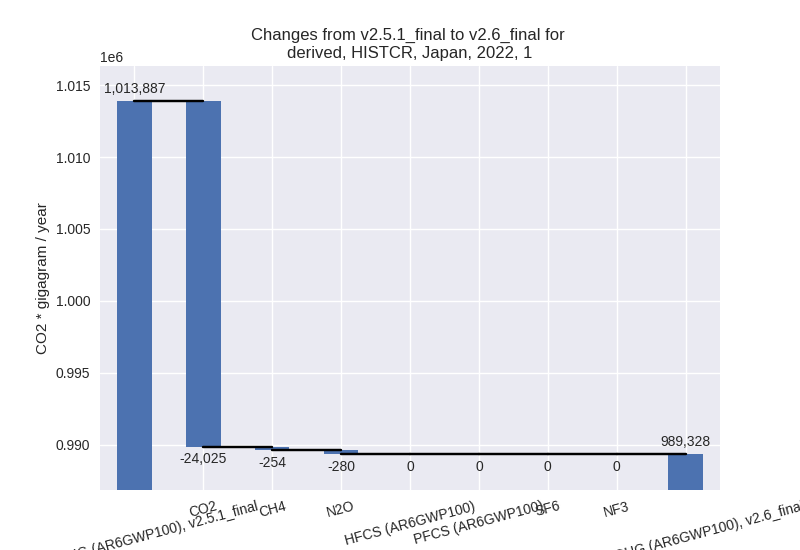
The changes come from the following subsectors:- 1.A: Total sectoral emissions in 2022 are 988148.29
Gg CO2 / year which is 99.9% of category 1 emissions. 2022 Emissions
have changed by -2.4% (-24676.91 Gg
CO2 / year). 1990-2022 Emissions have changed by -0.1% (-1216.67 Gg CO2 / year). For 2022
the changes per gas
are:
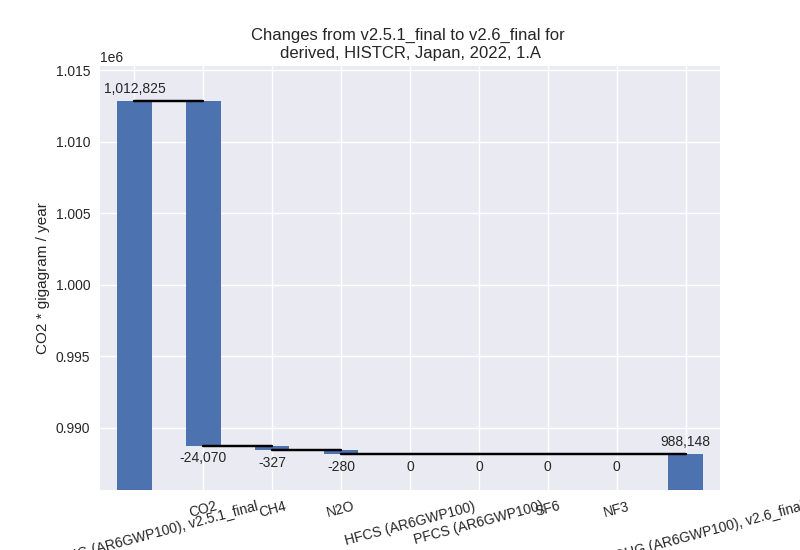
There is no subsector information available in PRIMAP-hist. - 1.B.1: Total sectoral emissions in 2022 are 512.31 Gg CO2 / year which is 0.1% of category 1 emissions. 2022 Emissions have changed by 1.6% (8.24 Gg CO2 / year). 1990-2022 Emissions have changed by 0.0% (0.71 Gg CO2 / year).
- 1.B.2: Total sectoral emissions in 2022 are 460.39
Gg CO2 / year which is 0.0% of category 1 emissions. 2022 Emissions have
changed by 15.5% (61.80 Gg CO2 /
year). 1990-2022 Emissions have changed by 21.1% (98.32 Gg CO2 / year). For 2022 the
changes per gas
are:
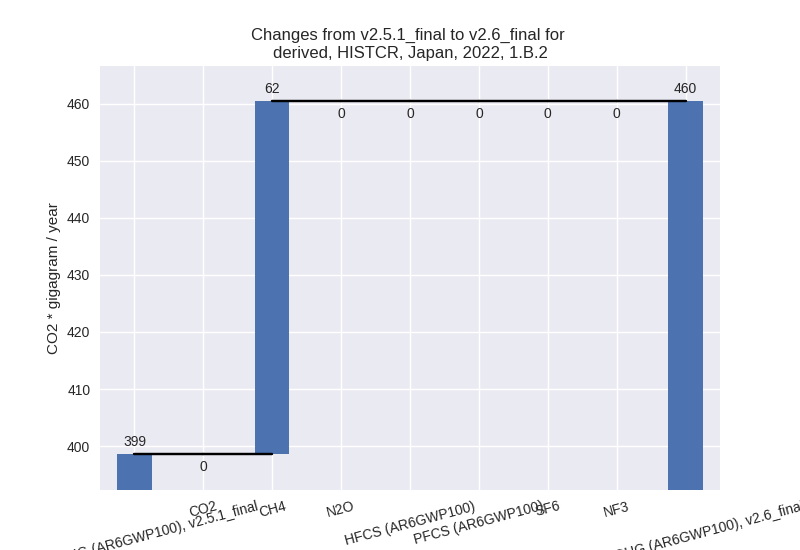
For 1990-2022 the changes per gas are: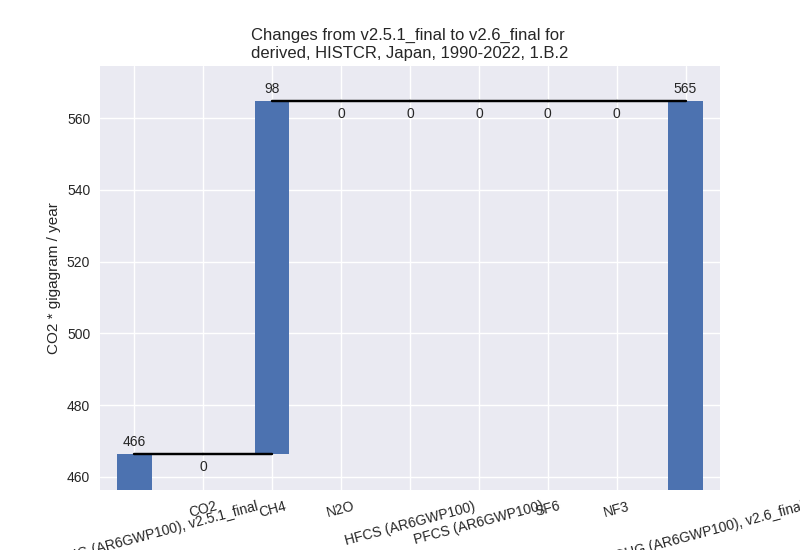
There is no subsector information available in PRIMAP-hist.
- 1.A: Total sectoral emissions in 2022 are 988148.29
Gg CO2 / year which is 99.9% of category 1 emissions. 2022 Emissions
have changed by -2.4% (-24676.91 Gg
CO2 / year). 1990-2022 Emissions have changed by -0.1% (-1216.67 Gg CO2 / year). For 2022
the changes per gas
are:
- 2: Total sectoral emissions in 2022 are 101719.77
Gg CO2 / year which is 8.9% of M.0.EL emissions. 2022 Emissions have
changed by -4.6% (-4883.69 Gg CO2 /
year). 1990-2022 Emissions have changed by 2.0% (2025.43 Gg CO2 / year). For 2022 the
changes per gas
are:
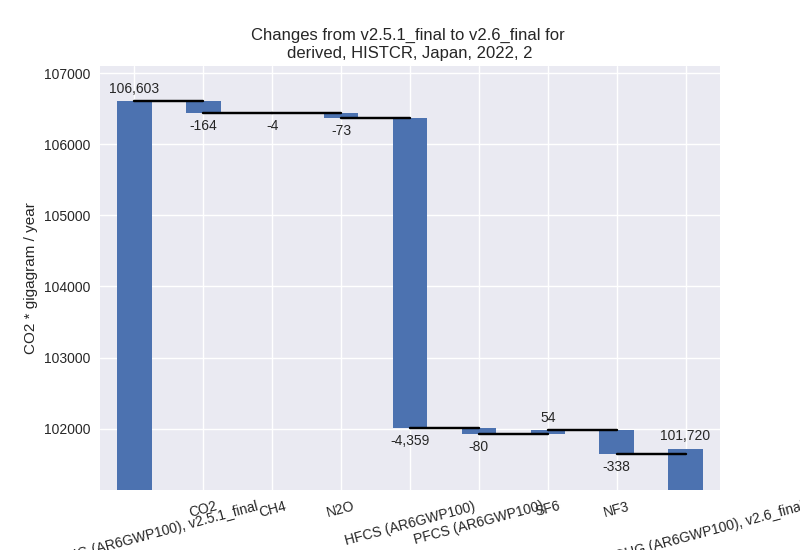
- M.AG: Total sectoral emissions in 2022 are 33682.69 Gg CO2 / year which is 2.9% of M.0.EL emissions. 2022 Emissions have changed by 0.4% (139.32 Gg CO2 / year). 1990-2022 Emissions have changed by 0.3% (92.41 Gg CO2 / year).
- 4: Total sectoral emissions in 2022 are 17607.16 Gg CO2 / year which is 1.5% of M.0.EL emissions. 2022 Emissions have changed by -0.9% (-152.56 Gg CO2 / year). 1990-2022 Emissions have changed by 0.0% (0.10 Gg CO2 / year).
- 5: Total sectoral emissions in 2022 are 2651.11 Gg
CO2 / year which is 0.2% of M.0.EL emissions. 2022 Emissions have
changed by -4.2% (-115.29 Gg CO2 /
year). 1990-2022 Emissions have changed by 19.7% (664.71 Gg CO2 / year). For 2022 the
changes per gas
are:
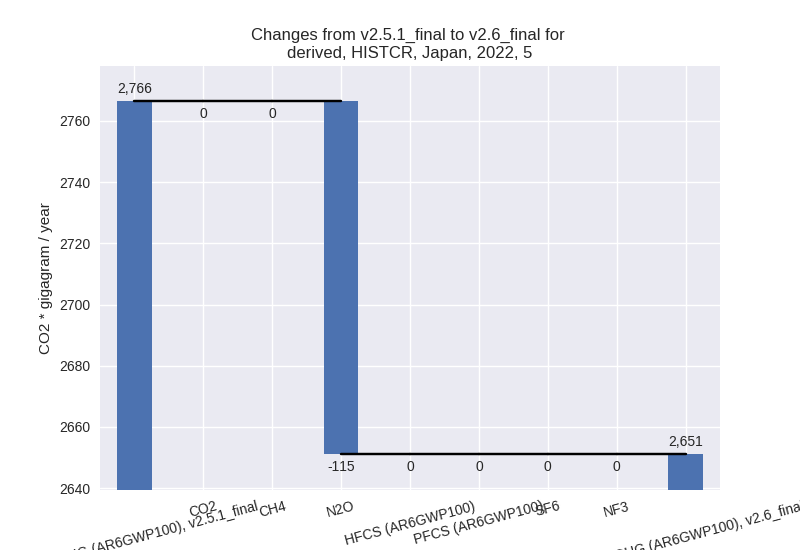
For 1990-2022 the changes per gas are: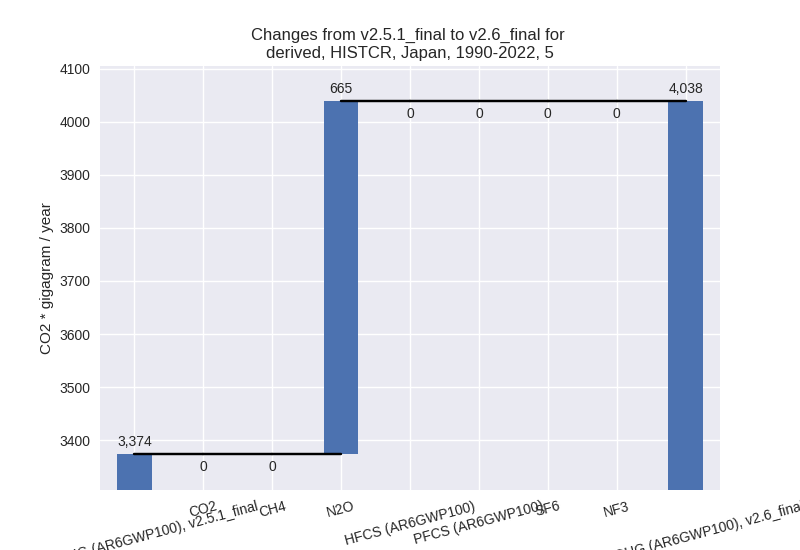
third party scenario (HISTTP):
Most important changes per time frame
For 2022 the following sector-gas combinations have the highest absolute impact on national total KyotoGHG (AR6GWP100) emissions in 2022 (top 5):
- 1: 2, HFCS (AR6GWP100) with -1068.37 Gg CO2 / year (-5.5%)
- 2: 2, CO2 with 782.94 Gg CO2 / year (1.5%)
- 3: 4, CH4 with 747.98 Gg CO2 / year (9.5%)
- 4: 1.A, CO2 with 696.40 Gg CO2 / year (0.1%)
- 5: 2, N2O with 461.02 Gg CO2 / year (43.6%)
For 1990-2022 the following sector-gas combinations have the highest absolute impact on national total KyotoGHG (AR6GWP100) emissions in 1990-2022 (top 5):
- 1: 2, CO2 with 836.05 Gg CO2 / year (1.2%)
- 2: 4, CH4 with 665.61 Gg CO2 / year (4.7%)
- 3: 5, N2O with 664.71 Gg CO2 / year (19.7%)
- 4: 2, N2O with 152.07 Gg CO2 / year (3.7%)
- 5: 4, N2O with 79.61 Gg CO2 / year (3.4%)
Changes in the main sectors for aggregate KyotoGHG (AR6GWP100) are
- 1: Total sectoral emissions in 2022 are 1028723.50 Gg CO2 / year which is 89.6% of M.0.EL emissions. 2022 Emissions have changed by 0.1% (744.20 Gg CO2 / year). 1990-2022 Emissions have changed by -0.0% (-13.27 Gg CO2 / year).
- 2: Total sectoral emissions in 2022 are 79854.15 Gg CO2 / year which is 7.0% of M.0.EL emissions. 2022 Emissions have changed by -0.1% (-41.80 Gg CO2 / year). 1990-2022 Emissions have changed by 1.2% (1212.26 Gg CO2 / year).
- M.AG: Total sectoral emissions in 2022 are 22791.99 Gg CO2 / year which is 2.0% of M.0.EL emissions. 2022 Emissions have changed by 0.0% (0.00 Gg CO2 / year). 1990-2022 Emissions have changed by 0.0% (0.00 Gg CO2 / year).
- 4: Total sectoral emissions in 2022 are 14650.75 Gg
CO2 / year which is 1.3% of M.0.EL emissions. 2022 Emissions have
changed by 8.5% (1152.20 Gg CO2 /
year). 1990-2022 Emissions have changed by 3.6% (739.75 Gg CO2 / year). For 2022 the
changes per gas
are:
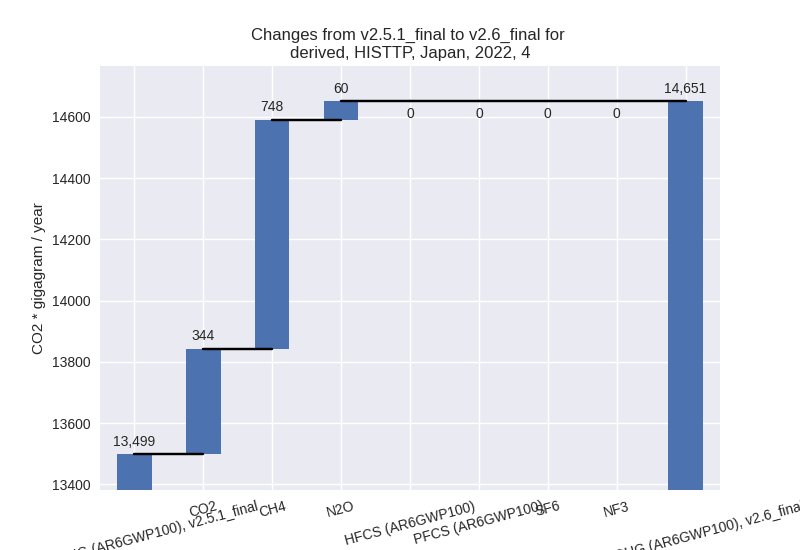
For 1990-2022 the changes per gas are: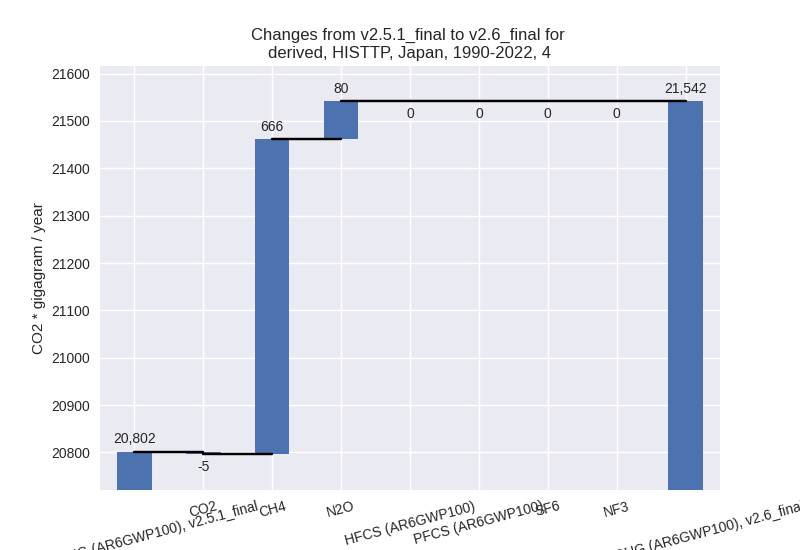
- 5: Total sectoral emissions in 2022 are 2651.11 Gg
CO2 / year which is 0.2% of M.0.EL emissions. 2022 Emissions have
changed by -4.2% (-115.29 Gg CO2 /
year). 1990-2022 Emissions have changed by 19.7% (664.71 Gg CO2 / year). For 2022 the
changes per gas
are:
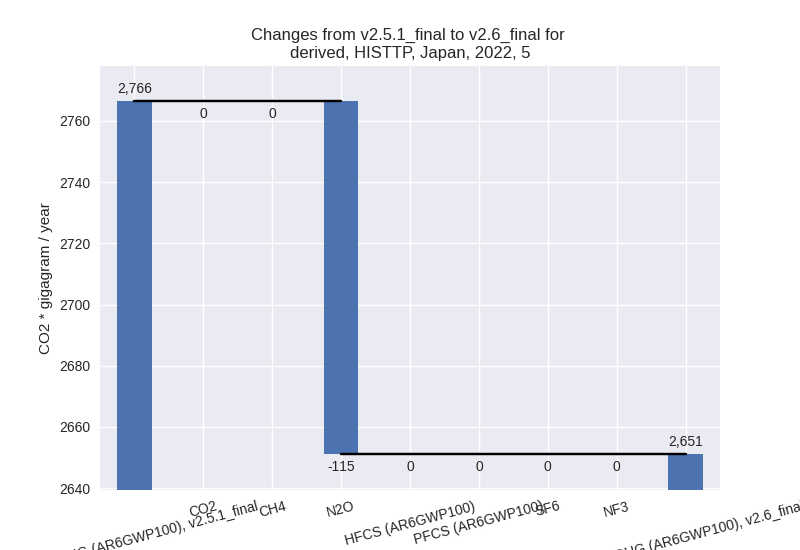
For 1990-2022 the changes per gas are: